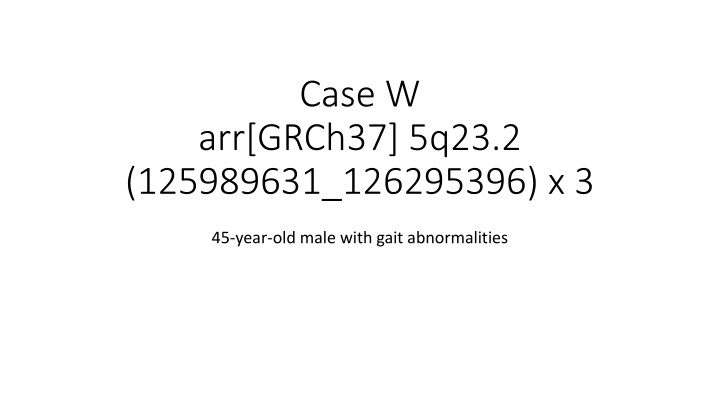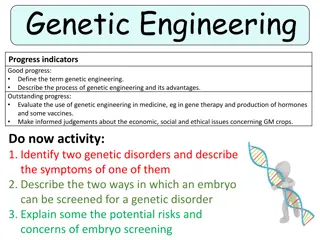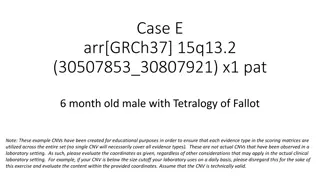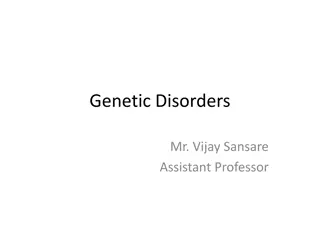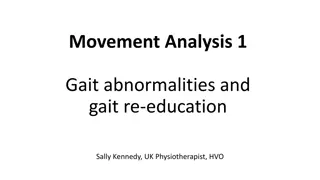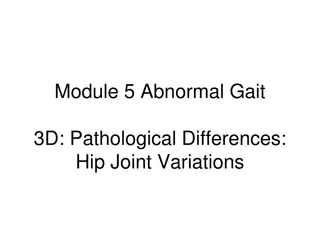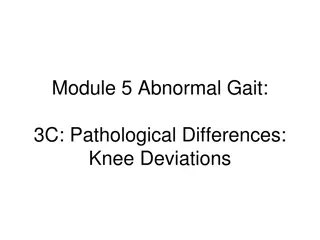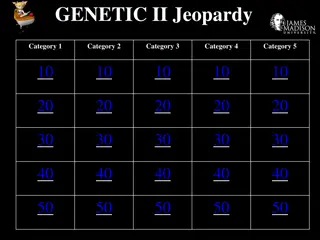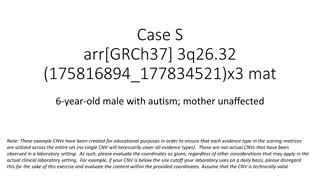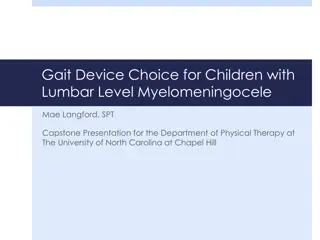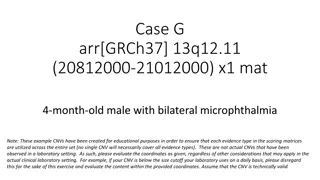Evaluation of Genetic Abnormalities in a 45-Year-Old Male with Gait Abnormalities
A 45-year-old male with gait abnormalities was referred for evaluation, with an unknown inheritance and deceased parents. His father had a history of ataxia and tremor. Using the GAIN scoring metric, the genomic content was assessed, including the presence of protein-coding genes, established TS genes, and the number of protein-coding genes in the interval. Further evaluation focused on the OMIM Morbid gene, LMNB1, associated with autosomal dominant leukodystrophy. Detailed molecular analysis of autosomal dominant leukodystrophy families was also referenced.
Download Presentation

Please find below an Image/Link to download the presentation.
The content on the website is provided AS IS for your information and personal use only. It may not be sold, licensed, or shared on other websites without obtaining consent from the author.If you encounter any issues during the download, it is possible that the publisher has removed the file from their server.
You are allowed to download the files provided on this website for personal or commercial use, subject to the condition that they are used lawfully. All files are the property of their respective owners.
The content on the website is provided AS IS for your information and personal use only. It may not be sold, licensed, or shared on other websites without obtaining consent from the author.
E N D
Presentation Transcript
Case W arr[GRCh37] 5q23.2 (125989631_126295396) x 3 45-year-old male with gait abnormalities
Clinical Information arr[GRCh37] 5q23.2 (125989631_126295396) x 3 45-year-old male referred for gait abnormalities Inheritance is unknown, parents are deceased. Patient reports father with history of ataxia and tremor. Use the GAIN scoring metric
Section 1: Initial Assessment of Genomic Content Case W Genes contained Would apply category 1A (contains protein-coding or other known functionally important elements), as this duplication includes protein-coding genes. 0 points; continue evaluation Total: 0 points
Section 2: Overlap with Established TS, HI, or Benign Genes/Genomic Regions Established TS Gene This duplication does include an established TS gene. In a typical evaluation, this could lead you to a classification of Pathogenic. However, for the sake of this example, we will be ignoring this in order to focus on how to evaluate the case- level data in the event this gene had not already been curated by ClinGen Dosage Sensitivity. Total: 0 points
Section 3: Evaluation of Gene Number c There are only 2 protein-coding genes in the interval (category 3A, 0 points). Total: 0 points
Section 4: Detailed Evaluation of Genomic Content Where to start? LMNB1 is an OMIM Morbid gene associated with autosomal dominant leukodystrophy (ADLD), so this is a logical first place to start.
Autosomal Dominant Leukodystrophy From GeneReviews Nahas et al. Autosomal Dominant Leukodystrophy with Autonomic Disease https://www.ncbi.nlm.nih.gov/books/NBK338165/
Giorgio et al. 2013 (PMID:23649844) Describes detailed molecular analysis of the largest collection of ADLD families studied to date (31 individuals from 20 independent families) Families from countries around the world: USA, Italy, Sweden, Germany, France, India, Canada, Israel, Brazil Reassuring to see individuals coming from various ethnic groups, unlikely to be related 9 had been described previously Pay attention to this type of information to make sure you are not counting cases twice Though duplications involving LMNB1 had all been identified previously in these individuals through various methods, samples were reanalyzed by the authors for the purposes of defining the boundaries of the duplications No comment was made on previous testing on any of the individuals to rule out other genetic causes of leukodystrophy 16 unique duplications were identified
Our case is very similar in genomic content to several of those reported in Giorgio. Any of these (with the possible, conservative exception of BR1) would be appropriate to use as case evidence This paper does not provide detailed information on family structure; the 6 previously unpublished cases here could be used in Category 4E (inheritance unknown). * * * *** * * * Case W *Previously published Giorgio et al. 2013, Figure 1A
Schuster et al. 2011 (A2, A3, A10, A11 in Giorgio et al.) 4 non-related families with ADLD with autonomic symptoms 2 Swedish, 1 German, 1 Israeli (of Arab descent) Samples from one affected patient from each family were analyzed by genome-wide SNP array Western blot analyses of lamin B1 were done on 5 individuals from the 2 Swedish families (including both probands) Showed significantly increased (~twofold) lamin B1 protein levels Levels of MARCH3 mRNA were similar between patients and controls Case W
= genotype + = sig. increased lamin B1 protein levels
Dos Santos et al. 2011 (G1 in Giorgio et al.) 47-year-old male with 2-year history of: Gait disturbance Micturition problems Personality changes Brain MRI: bilateral T2-hyperintense lesions in the subcortical and deep cerebral white matter Normal: lumbar puncture, nerve conduction studies, electromyography, AAs, LCFAs, and lysosomal enzymes 5q32.2 duplication involving LMNB1 gene identified on array in proband and 44-year-old sister Sister asymptomatic, but was also found to have hyperintense lesions of the subcortical and deep cerebral white matter on brain MRI = genotype + Our Case (W) Case G1 PMID:21909802
Other cases: Padiath et al. 2006 Describe 3 unique duplications from 4 families involving LMNB1 with variable involvement of the nearby MARCH3 gene 2 Irish-American families with identical duplications thought to arise by a common founder Candidate gene evaluation prompted by linkage analysis Functional studies show: Lamin B1 is overexpressed in brain tissue of affected individuals Increased expression of lamin B1 in flies resulted in a degenerative phenotype No difference in MARCH3 expression on Northern blot in brain tissue of affected individual vs. control Paper does not specify who was tested in each family/which individuals confirmed to have variant PMID:16951681
Other cases: Potic et al. 2013 Serbian family presenting with progressive pyramidal and cerebellar signs, slow cognitive decline, and late- stage autonomic dysfunction MRIs show bilateral T2- hyperintense lesions in the subcortical and deep cerebral white matter LMNB1 copy number assessed by quantitative RT- PCR _ _ _ _Genotype - Genotype + and many other cases available in the literature PMID:23681646
Putting it all together We have a wealth of information indicating that duplications of LMNB1 cause autosomal dominant leukodystrophy (ADLD) Genetic evidence from at least 15 probands (with more in the literature) Functional evidence showing increased lamin B1 protein levels in probands (leukocytes and brain tissue); overexpression in flies causes a degenerative phenotype; normal mRNA levels of frequently involved neighbor gene MARCH3 (likely more in literature) However, this scenario doesn t neatly fit our rules Testing not consistently done on affected family members can t demonstrate genotype+ status for segregation No known de novo cases Hitting category maximums
A note about category maximums Evidence Type Evidence Suggested Points/Case Max Score Category maximums were put in place to prevent certain evidence types from taking a case all the way to Pathogenic on their own without other, supportive information Goal is to encourage the collection of diverse pieces of information if available/appropriate In some circumstances, however, this is not possible Consider carefully if your situation warrants override of category maximum
Trying to avoid scenarios like this: If all of these people were genotype+, this family would have 11 segregations If we allowed increasing segregation data to score up to 1.0 points, a single family could drive the classification of a variant. This would be inappropriate, as segregation implicates a locus, not a variant.
In our case, we have: 15 different probands, all with positive family history, some with documentable segregation Supportive functional data Because the phenotype is adult-onset and does not appear to impact reproductive fitness, we have families with numerous affected individuals and no (documented) de novo cases Achieving a variety of genetic evidence types is not possible in this case. This is a well-studied gene-disease relationship with extensive evidence, and an example of when it would be appropriate to override category maximums.
Segregations (being conservative) Dos Santos et al. 2011 - 1 Potic et al. 2013 (counting intervening obligate carriers) 4 Total: 5 segregations (0.30 points)
What about the rest of the cases? Could count the other 13 cases at the most conservative level (0.10 points each): > 1.0 points in addition to the segregation data This is the same amount of points assigned for assumed de novo, non-specific phenotype (4C) and specific phenotype, unknown inheritance (4E) The number of observed cases, not the number of segregations, is driving this classification The specificity of the phenotype, the large amount of data, and the supportive functional data can all serve as rationale for this scoring change
Category 5: Incorporating our patients data Our patient is a 45-year-old man with gait abnormalities. His parents are deceased, but he reports a history of a father with ataxia and tremor. This is consistent with ADLD, but could also be indicative of a number of other things. Quick search for gait abnormalities among Clinical Synopses in OMIM returns over 1000 matches With this information alone, consider scoring with Category 5G (nonspecific but consistent phenotype) When you call the ordering clinician to discuss the case, they reveal that the patient has had a brain MRI, which demonstrated findings consistent with leukodystrophy. OMIM Clinical Synopses search for leukodystrophy = 47 results With this more specific information, consider awarding full points within Category 5H (up to 0.30).
Summary PATHOGENIC Evidence supporting pathogenicity includes: numerous (13+) probands with similar duplications reported in the literature with diagnoses of ADLD (scoring at 0.10 points each = >1.0 points) At least two families with documented segregation of the duplication among affected family members (0.30 points) Patient under evaluation has a phenotype consistent with what has been previously reported (0.30 points with MRI evidence of leukodystrophy) Supportive functional data
